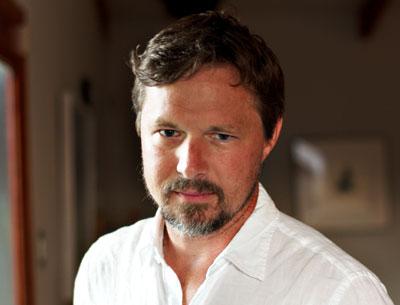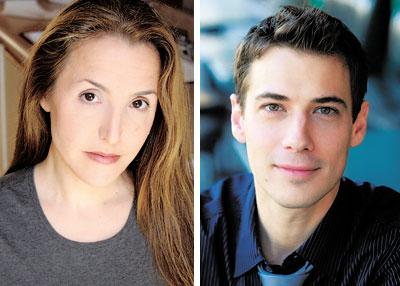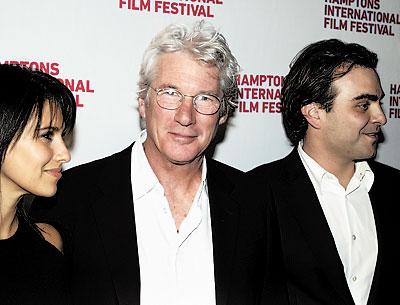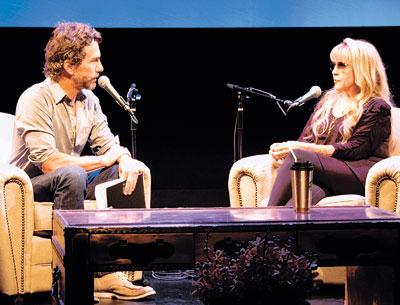Long Island Books: An Artist of Many Names and Talents
Long Island Books: An Artist of Many Names and Talents
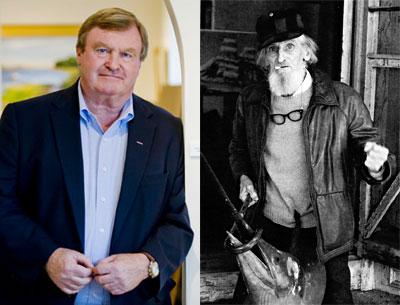
So when this mysteriously titled art book, “Cappy,” written by Terry Wallace, an East Hampton gallerist, crossed my desk, I asked myself, who is Cappy? I was quickly reminded of an old adage regarding artists’ monographs — beware the dust jacket of an art book that doesn’t illustrate art. The cover’s photograph is of a craggy middle-aged Scandinavian fisherman type, squinting directly at me and the camera. And the illustration on the back is a haunting photograph of the same person as an ancient mariner.
But the book’s subtitle is “The Life and Art of C. Hjalmar Amundsen,” clearly putting the word “life” in front of “art.” So I thumbed through the text and illustrations to find some beautiful and carefully painted scenes of whalemen on the hunt, the Cedar Point lighthouse, World War II Navy ships, a brig passing Culloden Point, and Rockport’s famous Motif No. 1 and Gloucester Harbor in Massachusetts. Well-delineated and dramatically composed works representing realist regional 20th-century American painting.
Then there are the photographs of a 1950s art show at Tuma’s tackle shop in Montauk, the artist in costume for a 1930s Beachcombers Ball in Provincetown, Mass., and posing with a harpoon at the Sag Harbor Whaling Museum. So I flipped through again and saw some very schematic paintings that are so generic as to be clearly decorative. Are these different periods? No, here is an artist who did over-the-sofa work for commercial sales and careful and handsome work that he could be proud of, for art-loving clients. This was going to be an unusual art book.
The distance between museum art and “Saturday Evening Post” covers was very clear when I started to camp out in my high school art room in the 1960s. Norman Rockwell was not an artist. Andrew Wyeth was not an artist either. They and the “designers” of record jackets, paperback book covers, and greeting cards were all not part of the pantheon of fine art. Fine art was above these popular narrative images. My teacher, Mrs. Webster, had a name for this other kind of non-art. It was called calendar art — and this was not a compliment. Be it the Currier & Ives reprints on my grandmother’s calendar, the hunters and their sleek bird dogs on my father’s calendar, or the hardly covered women on the greasy calendar at the Ford garage — this was not art. My small upstate New York town seemed very interested in compartmentalization. Things were so black and white. This was the olden times when men were men, women were women, and fine art was fine unless it wasn’t.
By the time I hit college, all hell had broken loose in the visual and performing arts, and as Cole Porter so aptly penned, “anything goes,” and it is still going.
After finishing the book, I can say that Cappy Amundsen’s life and works unfold into a tale that might be more common than most of us know, but has rarely been so carefully documented. In an art world that helps promote Jeff Koons-type hucksterism, this monograph reminds us all of that thin line between hokum and hosannas. What is captivating about Mr. Wallace’s entertaining and educational tome is that it introduces us to an astonishing person, C. Hjalmar Amundsen (known to his friends as Cappy), whose life is possibly more a work of art than some of his canvases.
“Cappy”
Terry Wallace
M.T. Fine Arts and
Sag Harbor Whaling Museum, $35
It also chronicles a rich period (1930s to 1960s) of cultural change by following this engagingly picaresque character who wove himself into the fabric of his adopted village of Sag Harbor. The story starts with Mr. Wallace and his serendipitous discovery and purchase of a box of Amundsen’s scrapbooks, but first a digression.
It should be stated that Mr. Wallace’s East Hampton Village gallery features 19th and 20th-century representational art that focuses on the land and seascapes of eastern Long Island. Childe Hassam and the Moran family of artists are his stock in trade. When a Sag Harbor resident stopped by the Wallace Gallery in 1996 to ask if Terry had any Cappy paintings for sale, Mr. Wallace didn’t know what the gentleman was talking about. Within an hour the story of Sag Harbor’s beloved, eccentric artist was shared and Mr. Wallace’s curiosity was stoked. He wondered how this artist’s work had eluded him and began searching out works by Cappy in private collections in Sag Harbor as well as in that village’s library and whaling museum.
In 2007, Mr. Wallace started a popular series of short interviews involving local citizens on WLNG Radio. He asked his audience to share their Cappy stories, and soon after that the box of Amundsen’s memorabilia arrived at his gallery door. What was contained in this hoard is the tale of a talented boy and his fascinating life in and out of (and around) the world of fine and commercial art as it existed a century ago. The scrapbooks proved to be an autobiographical collage. They are filled with newspaper clippings, faded and discolored Polaroid snapshots, gallery guides, and programs. This array of life’s highlights was just waiting to be cataloged, scrutinized, and strung together into an impressionistic portrait.
As Mr. Wallace started his research project, he jotted down adjectives that he found associated with Cappy Amundsen, such as “bohemian, intelligent, complicated, athletic, obstinate, individualistic, opinionated, innovative, dedicated, assertive, committed, strong, visionary, cantankerous, adventurous, even-tempered, alcoholic, talented, competitive, trusting, headstrong, realist, naturalist, ecologist, versatile, independent, disorganized, passionate, generous,” and more. These combined character traits would have challenged the best of the writers of black-and-white-era TV soap operas.
What comes out of this material is a childhood surrounded by creative people. Cappy’s grandfather born in Norway was a stone carver who worked on Henry Hobson Richardson’s grand New York State Capitol building, and his son (Cappy’s father) was an illustrator. Though the family had first settled in Williamsport, Pa., Cappy’s life started in Brooklyn in 1911. When he was 4, his family moved to Hackensack, N.J. His father was well employed and enjoyed fishing on Long Island’s East End. Cappy remembered seeing a photograph of the two of them posed beside the Sag Harbor bridge when he was but 2.
Amundsen attended good schools (Fairmount Academy and Blair Academy) and enjoyed the Pine Bluff Camp in Port Jefferson during his early summers. It was there that he fell in love with sailing. But for years a scandal hung over the head of Cappy’s father — his first wife left him and ran off with the violinist Janos Rigo, who was also married. It was a popular story with the newspapers, and though today the whole matter seems tame, it remained a topic from 1907 until 1934. And even after Cappy’s father divorced his wife in 1910 and soon remarried, his embarrassment didn’t subside.
When his father’s second wife, Cappy’s mother, died in early 1929, the family fell apart. The crash of the stock market didn’t help either.
Interestingly, Cappy was born Casper Hjalmar Emerson III. It was after his mother died that he adopted the last name of Norway’s most famous polar explorer, Roald Amundsen. This became legal years later, and it was just one of Cappy’s aliases. Cappy said that he had not been encouraged by his father to become an artist. But his father remained employed during the Depression, and this might have been inspiration enough for a kid with a high school diploma seeking a job.
He found part-time work with a gallery on New York’s lower Fifth Avenue as a designer, and he studied at the Grand Central School of Art. It was a time when a number of artists influenced by the Ashcan School began to search for American subjects. Unlike the 19th-century Hudson River School that inspired the public with its deep nationalistic feelings for the American wilderness, this later generation of realist painters didn’t look for sublimity, but rather used a painterly gutsiness when applying their fluid brushwork to images of Gloucester Harbor and Rockport wharves.
These colorful paintings are filled with dock crews and commercial fishing fleets. Artists like Emile Gruppe and Anthony Thieme dashed through New England scenes that seem comforting today, but were American post-impressionism then, and (because of their vacation locations) quickly became pleasing and profitable for their practitioners.
Cappy went to Maine and would have had to make a point not to see this art. When Cappy arrived back from New England, he must have carried rolls of completed seascapes and dock scenes, because on May 28, 1932, he registered with the Artists Aid Committee to have his work in the first Washington Square Art Show. A photograph from 1936 shows the artist exhibiting oil and watercolor paintings of Rockport Harbor, three-masted ships, portraits, and sailboats, all hanging or leaning on the wrought-iron fence surrounding Washington Square. He continued to have work in the show for 30 years. He spent time in Provincetown painting, playing with its avant-garde summer folk, and picking up money working in the commercial fishing industry.
He visited Sag Harbor again in 1945 and bought a house there soon after. He and his wife fell in love with what has been described as a scrappy village during those years. Mr. Wallace devotes much time to Cappy’s role in his new community and captures all the charms of a small town not yet discovered by the summer people. His paintings began to pay homage to the village’s 19th-century off-shore whaling industry and its winding streets, old houses, and beautiful harbor. He painted, he played, and he drank.
It is all interesting, if not sad. But what is a most amazing revelation is Mr. Wallace’s discovery of Cappy and his painting industry. Yes, I said industry. There is no other way to see it. Cappy Amundsen signed hundreds of his paintings using a variety of pseudonyms. There are several theories espoused, but I think the jury is still out. He signed paintings as Hjalmar, A. Emerson, J.J. Enwright, W. Hughes, Wm. Ward Jr., F.H. McKay, H. Nansen, Sven Sagg, R.B. Cooper, J.C. Bennett, John Dunne, L.C. Bonac, and many others. Humor is certainly present in some, and others are most likely jokes on friends’ (or enemies’) names. I would like to own a canvas by either L.C. Bonac or Sven Sagg. The art may be in the name.
It could be that his prolific output made galleries nervous. Rather like certain mystery writers who feel that one book a year is enough for loyal readers, so the second and third books have different detectives and “different” authors. Please don’t let the public know that the artist keeps six canvases going at a time and completes them all before dinnertime. Could be, but it seems that these generic works were geared for a clientele that really wouldn’t care. I think it’s the artist’s sense of humor — perverse in the best sense of the word.
You will enjoy meeting Cappy and riding the wide swings in his life and art. He illustrated books, designed posters, painted the New England harbor scene on your Sag Harbor aunt’s wall, and made friends everywhere he went. He taught local artists, founded Sag Harbor’s first outboard racing regatta, organized the Sea Scouts and the Montauk Sailing Club, and created an extraordinary screen of wire fish for an exhibition at East Hampton’s Guild Hall.
Thanks to Terry Wallace and that box of scrapbooks, we have all discovered Cappy, but certainly not all his secrets.
—–
Richard Barons is the executive director of the East Hampton Historical Society. He lives in Springs.
Earlier this year, “Cappy” won an Independent Publisher Regional Book Award, or Ippy, for best nonfiction title in the Northeast. Cappy Amundsen died in 2001.

